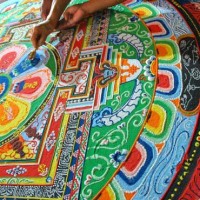
The Sakya tradition is closely bound up with the Khon ancestral lineage, which derived from celestial beings. The lineage has descended intact up to the present time from Khon Könchok Gyelpo (1034-l 102), founder of the Sakya tradition.
From the doctrinal point of view the tradition traces its origins to the Indian Yogin Virupa through Gayadhara. His disciple Drogmi Shakya Yeshe (992-1074) travelled to India where he received teachings on the Kalachakra, the Path and its Fruit and others from many Indian masters and returned to Tibet.
Later, Khon Könchok Gyelpo, one of his main disciples, built a monastery in the Tsang province of central Tibet and named it Sakya, or Grey Earth monastery. So the school took its name, Sakya, from the location of the monastery.
Khon Könchok Gyelpo’s son Sachen Kunga Nyingpo (1092-1158) was a person of extraordinary skill and spiritual attainment, who held all the lineages of tantra and sutra teachings of Arya Nagarjuna and Virupa. He had four sons – Kungabar, Sonam Tsemo, Jetsun Dakpa Gyeltsen and Palchen Rinpochey.
The second son Sonam Tsemo (1142-82) became a learned scholar at the early age of sixteen. He had visions of many meditational deities and also produced many realised disciples. Jetsun Dakpa Gyeltsen (1147-1216) received lay celibacy vows and showed strong signs of spiritual maturity in his youth. At the age of eleven he gave his first Hevajra teaching.
The principal disciple of Jetsun Dakpa Gyeltsen was his nephew, son of Palchen of Öpochey the famous Sakya Pandita Kunga Gyeltsen (1182-1251). Sakya Pandita studied Buddhist and non-Buddhist philosophy, logic, Sanskrit, poetry, astrology and art with countless Indian, Nepalese, Kashmiri and Tibetan masters and achieved mastery over them.
When he was twenty-seven years old, after meeting with the Kashmiri Pandita Shakya Shribhadra, he became a fully ordained monk and maintained his vows without least infraction. His works such as the Treasury of Logic on Valid Cognition (Tsad-ma rigs-gter) and the Discrimination of the Three Vows (sDom-gsum rab-dbye) are famous even to this day.
In 1244, Godan Khan, grandson of Chingis Khan, intrigued by Sakya Pandita’s reputation, invited him to Mongolia, where he gave Buddhist teachings. Later, in 1253, after both Sakya Pandita and Godan Khan had passed away, the emperor, Sechen Kublai Khan invited Drogön Chögyal Phagpa, nephew of Sakya Pandita to his court.
Phagpa invented a new script in which to write the Mongolian language. Kublai Khan was so impressed by Phagpa’s performance that he declared Buddhism the state religion of Mongolia and presented him the rule of the three provinces of Tibet. Thus, Phagpa was the first person in Tibetan history to gain religious and secular authority over the whole country. He was succeeded by his brother Chagna and altogether the Sakyapas ruled Tibet for more than a hundred years.
Eventually, Tishri Kunglo (1299-1327), eldest of the fifteen grandsons of Sakya Pandita’s brother, founded four dynastic houses: Zhithog, Rinchen Gang, Lhakhang and Ducho, of which only the last two dynasties have survived. However, in fifteenth century the Ducho dynasty split into two sub-dynasties, or palaces the Dolma Phodrang and Phuntsok Phodrang.
The present hierarchs of these two palaces are Sakya Trizin, Ngawang Kunga Theckchen Rinpochey (b. 1945). who is the current head of the Sakya tradition, and lives in Dehra Dun, India and, Dagchen Rinpochey (b. 1929), the founder of Sakya Thegchen Choling in the United States of America.
Succession to the position of head of the Sakya tradition has been hereditary since the time of Khon Könchok Gyelpo and traditionally alternates between the two palaces. Sakya Dagtri Rinpochey, the present incumbent is the 4lst occupant of the Sakya Throne.
Amongst the principal holder of the Sakya tradition, Sachen Kunga Nyingpo (1092-1158), Sonam Tsemo (1142-1182), Dakpa Gyeltsen (1147-1216), Sakya Pandita Kunga Gyeltsen (1182-1251) and Drogön Chögyal Phagpa (1235-1280) are known as the Five Patriarchs of the Sakya tradition.
After them, were the so called Six Ornaments of Tibet: Yaktuk Sangyey Pal and Rongton Mawe Sengey, who were reputed for their authority on sutra teachings; Ngorchen Kunga Zangpo and Zongpa Kunga Namgyel, who were learned in the tantras; Goram Sonam Sengey and Shakya Chogden who were learned in both sutras and tantras. These were famous spiritual masters of Sakya tradition. Amongst them Gorampa Sonam Sengey, instituted the formal study of logic in Sakya tradition.
Like other traditions of Tibetan Buddhism, a number of sub-divisions emerged within the main Sakya tradition. The lineage of teachings within the discipline instituted by Ngorchen Kunga Zangpo (1382-1457) and successive masters such as Könchok Lhundrup, Thartse Namkha Pelsang and Drubkhang Pelden Dhondup have come to be known as the Ngor lineage, whereas, the lineages of Tsarchen Losel Gyatso (1502-56), called the whispered-lineage of Tsar, concerning the Thirteen Golden Texts of Tsar, including the secret doctrines of the greater or lesser Mahakala, Vajra Yogini, Jambhala and others, is known as the Tsar tradition.
Thus, the Sakya school of the Khon lineage represents the main trunk of a tree, of which the Ngorpa and Tsarpa schools are branches. These are, the three schools (Sa-Ngor-Tsar-gsum) in Sakya tradition.
The central teaching and practice of the Sakyapa, called Lamdrey (Lam-’bras), the Path and Its Fruit, ultimately leads a practitioner to the state of Hevajra. The Path and Its Fruit is a synthesis of the entire paths and fruits of both the exoteric and esoteric classes of teachings.
The Path and Its Fruit teaching originating from the Indian teachers Virupa, Avadhuti, Gayadhara and Shakyamitra, a follower of Arya Nagarjuna, were brought to Tibet by the Tibetan translator Drogmi and have been passed down through an unbroken lineage of masters until today.
During the time Muchen Sempa Chenpo Könchok Gyeltsen, a disciple of Ngorchen Kunga Zangpo (1382-1457), the Path and Its Fruit transmission broke into two sub-traditions: the Explanation for Private Disciples (sLob-bshad) and for Assemblies (Tshog-bshad) traditions.
The philosophical viewpoint expressed in the Path and Its Fruit is the inseparability of samsara and nirvana. According to this, an individual cannot attain nirvana or peace by abandoning samsara or cyclic existence, because the mind is the root of both samsara and nirvana. When obscured, it takes the form of samsara and when freed of obstructions it is nirvana. Hence, the reality is that a person must strive through meditation to realise their inseparability.
In the Sakya monastic universities eighteen major texts are thoroughly studied. These deal with the Perfection of Wisdom, Monastic Discipline, Middle Path View, Phenomenology, Logic and Epistemology, as well as commentaries unique to the tradition, such as the Discrimination of the Three Vows, the Treasury of Logic on Valid Cognition and the works of Gorampa Sonam Sengey and others.
On graduation, a monk is granted the degree of Kazhipa, Kachupa and Rabjampa on the basis of merit. The main tantric practices of the Sakya school are the Hevajra and Chakrasambhara tantras, Mahakala and so forth.
The major Sakya monasteries in Tibet were Nalanda in Phenpo built by Rongton Sheja Kunrig, Lhakhang Chenmo, founded by Khon Könchok Gyelpo, Tsedong Sisum Namgyel, established by Namkha Tashi Gyeltsen and Ngor E-Vam Chodhen, founded by E-Vam Kunga Zangpo in Central Tibet; Dhondup Ling, founded by Dagchen Sherab Gyeltsen and Lhundup Teng founded by Thangtong Gyalpo in Kham; and Deur Chode built by Chodak Sangpo in Amdo.
Presently, Tsechen Tenpai Gatsal in Rajpur, Uttar Pradesh; Ngor E-Vam Shadrup Dargye Ling in Bir, Himachal Pradesh, Tsechen Dhongag Choeling in Mundgod, Karnataka State, and Ngor E-Vam Chodhen in Dehradun, Uttar Pradesh in India as well as Tashi Rabten Ling at Lumbini in Nepal are some of the principal re-established monasteries of the Sakya tradition.
Source: Historical Introduction to the Five Principal Spiritual Traditions of Tibet








